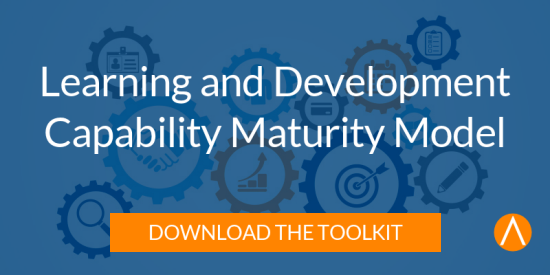Posted by Caveo Learning ● June 2, 2016
What Learning Leaders Want from Vendor Relationships
 All learning and development organizations need help from outside vendors now and again, whether for something relatively basic like facilitating additional training sessions, or a more complex relationship with a consulting firm for a top-to-bottom learning strategy overhaul.
All learning and development organizations need help from outside vendors now and again, whether for something relatively basic like facilitating additional training sessions, or a more complex relationship with a consulting firm for a top-to-bottom learning strategy overhaul.
On the whole, learning leaders are satisfied with their external learning partners and vendors, according to a recent survey by Chief Learning Officer magazine. But there are certain areas—metrics and alignment, to name two—where many third-party learning organizations seemingly come up short.
The most critical aspects of positive external learning partner relationships, as reported in the CLO survey, are to be expected. Nine out of ten learning leaders rated product quality, easiness to work with, value, and overall results as high priorities when selecting vendors—no real surprises there. Those qualities essentially boil down to, “Will we get something that does what we need it to do at a good price and without a lot of headaches?” The more telling responses come further down the CLO list: two-thirds of respondents rate customization from their learning vendors as a high priority, and more than half want partners that can deliver thought leadership, innovation, and problem solving.
We know what learning leaders want from vendors, but how satisfied are they with the actual results? The CLO survey found that most learning leaders are happy with external learning partners when it comes to delivering learning (91%), content development (85%), and executive coaching (83%). Learning consultants scored at 80% satisfaction, and learning technologies had a 75% satisfaction rate.
Measurement and Analytics Continues to Be a Pain Point
Not surprisingly, the area that L&D leaders are least satisfied with is analytics—only 68% reported being satisfied with the analytics provided by their vendors, and just one in four is very satisfied. Only fairly recently has the L&D industry as a whole begun to embrace business-focused analytics, measuring the things that directly impact bottom-line success, rather than concentrating on learning metrics that are meaningless to folks outside learning organizations. It follows, then, that learning vendors often fail to meet expectations when it comes to meaningful analytics—it hasn’t been something that many learning leaders have previously demanded.
 How can you know if a would-be vendor really understands and delivers quality analytics? You might start by gauging the organization’s familiarity with and adherence to Talent Development Reporting principles, as put forth by the nonprofit Center for Talent Reporting. TDRp is an industry-led initiative to bring standards and business discipline to L&D, providing standard measures and reports that facilitate upfront planning, backend performance measurement, and continuous improvement. Chances are, the vendor won’t have TDRp certification—Caveo Learning is currently the only firm with TDRp Consultancy Certification—but if the vendor is not at least fluent in TDRp concepts, that's a red flag.
How can you know if a would-be vendor really understands and delivers quality analytics? You might start by gauging the organization’s familiarity with and adherence to Talent Development Reporting principles, as put forth by the nonprofit Center for Talent Reporting. TDRp is an industry-led initiative to bring standards and business discipline to L&D, providing standard measures and reports that facilitate upfront planning, backend performance measurement, and continuous improvement. Chances are, the vendor won’t have TDRp certification—Caveo Learning is currently the only firm with TDRp Consultancy Certification—but if the vendor is not at least fluent in TDRp concepts, that's a red flag.
Beyond TDRp familiarity, your vendor partners should at least be able to detail processes around data gathering and reporting. Find out which metrics they deem valuable and why, and then put your business acumen cap on—will those analytics provide meaningful insight into whether your learning initiative is successful from an ROI perspective? Will someone without an L&D background be able to identify value based on those metrics? If the answer to either question is no, then you will probably ultimately feel some dissatisfaction with that vendor.
Alignment Also Lacking
 Along with better analytics, another critical trait that L&D leaders are lacking from their vendor partners is business alignment. Survey respondents told CLO that great partners align with organizational needs, as opposed to “having a solution looking for a problem to solve.” When vendors are more interested in selling a product than solving your problem, it may be evident by the questions they’re asking you—are they directed at identifying the root causes of your organizational needs, and do they attempt to understand your overriding business objectives?
Along with better analytics, another critical trait that L&D leaders are lacking from their vendor partners is business alignment. Survey respondents told CLO that great partners align with organizational needs, as opposed to “having a solution looking for a problem to solve.” When vendors are more interested in selling a product than solving your problem, it may be evident by the questions they’re asking you—are they directed at identifying the root causes of your organizational needs, and do they attempt to understand your overriding business objectives?
CLO offers some basic recommendations for selecting and sourcing learning providers:
- Ensure stakeholders agree on organizational requirements.
- Use your industry connections to vet and assess would-be partners.
- Expect more than you’re offered at first blush.
We’d like to make a few more suggestions of our own:
- Analyze rates using both internal and external data sources, including benchmarking across multiple suppliers, to make sure pricing is accurate and appropriate.
- Have a solid understanding of the vendor’s offerings around strategic planning. As evident from the CLO survey results, not all firms care about business alignment, and even fewer do it well.
- Factor in the experience level of the firm’s associates. Any company can provide warm bodies; expertise and breadth of knowledge matter.
Finally, ask around for references. The learning and development community is relatively small—odds are, someone in your network knows someone who can give a firsthand account of the company’s ability to meet deadlines, provide strategic support, and deliver the kind of flexible, customized learning solution that you’re looking for.
Topics: Learning Strategy

